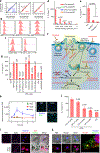Physical activation of innate immunity by spiky particles
- PMID: 30374159
- PMCID: PMC7432992
- DOI: 10.1038/s41565-018-0274-0
Physical activation of innate immunity by spiky particles
Abstract
Microbial biochemicals have been indicated as the primary stimulators of innate immunity, the first line of the body's defence against infections. However, the influence of topological features on a microbe's surface on immune responses remains largely unknown. Here we demonstrate the ability of TiO2 microparticles decorated with nanospikes (spiky particles) to activate and amplify the immune response in vitro and in vivo. The nanospikes exert mechanical stress on the cells, which results in potassium efflux and inflammasome activation in macrophages and dendritic cells during phagocytosis. The spiky particles augment antigen-specific humoral and cellular immune responses in the presence of monophosphoryl lipid A and elicit protective immunity against tumour growth and influenza viral infection. The study offers insights into how surface physical cues can tune the activation of innate immunity and provides a basis for engineering particles with increased immunogenicity and adjuvanticity.
Conflict of interest statement
Competing interests
The authors declare no competing interests.
Figures






Comment in
-
A spike in inflammation.Nat Nanotechnol. 2018 Nov;13(11):980-981. doi: 10.1038/s41565-018-0292-y. Nat Nanotechnol. 2018. PMID: 30374158 No abstract available.
-
Immune response by touch.Nat Rev Immunol. 2018 Dec;18(12):730-731. doi: 10.1038/s41577-018-0090-7. Nat Rev Immunol. 2018. PMID: 30420704 No abstract available.
References
-
- Medzhitov R Toll-like receptors and innate immunity. Nat. Rev. Immunol. 1, 135–145 (2001). - PubMed
-
- Petrovsky N & Aguilar JC Vaccine adjuvants: current state and future trends. Immunol. Cell Biol. 82, 488–496 (2004). - PubMed
-
- Reed SG, Orr MT & Fox CB Key roles of adjuvants in modern vaccines. Nat. Med. 19, 1597–1608 (2013). - PubMed
Publication types
MeSH terms
Substances
Grants and funding
LinkOut - more resources
Full Text Sources
Other Literature Sources

